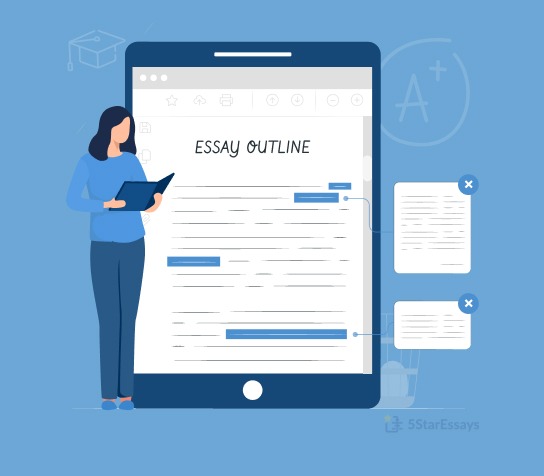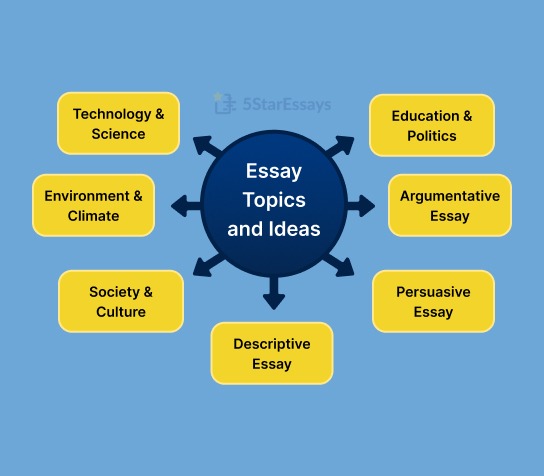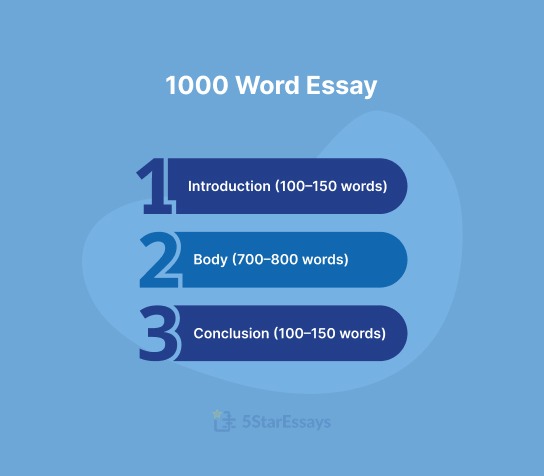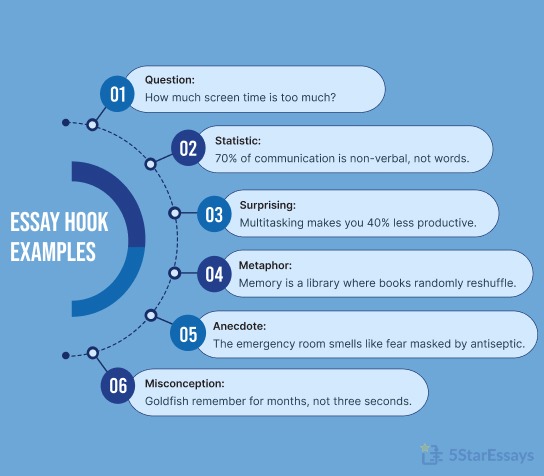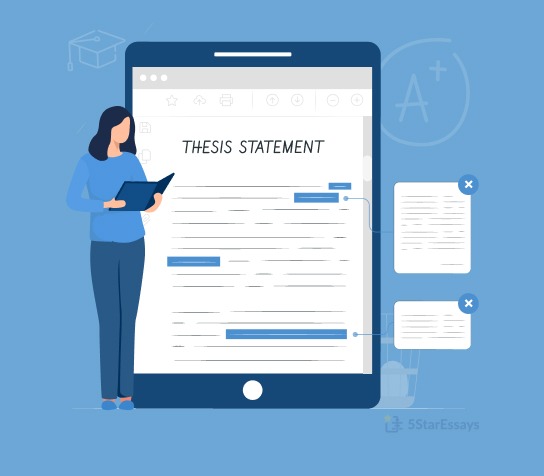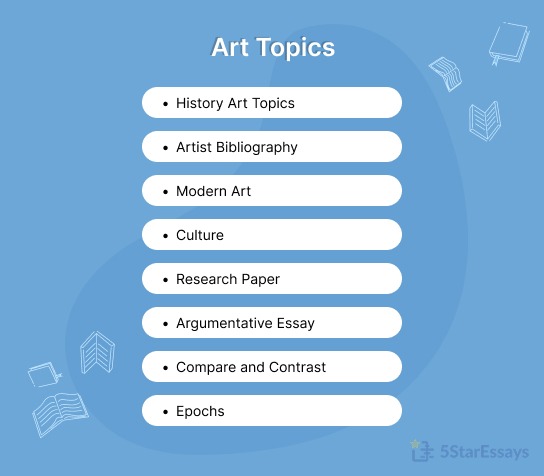Quick Reference: Finding the Right Transition Word
Before diving into comprehensive lists, use this decision framework to identify which category you need:
What Are You Trying To Do?
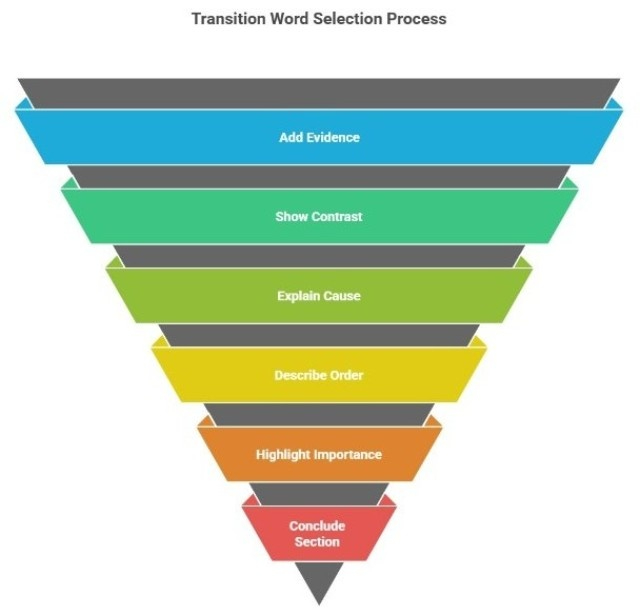
Add more supporting evidence or examples? = Use Addition Transitions: furthermore, moreover, additionally, in addition
Show contrast or present an opposing view? = Use Contrast Transitions: however, nevertheless, on the other hand, conversely
Explain why something happened or show results? = Use Cause-Effect Transitions: therefore, consequently, as a result, thus
Describe steps, order, or time progression? = Use Sequential Transitions: first, second, next, then, finally
Highlight an especially important point? = Use Emphasis Transitions: indeed, in fact, notably, significantly
Wrap up a section or conclude your essay? = Use Conclusion Transitions: in conclusion, ultimately, in summary, overall
This simple framework helps you choose the right transition in seconds. Now let's explore each category in depth with real examples.
Understanding Transition Words: Beyond the List
Most students think transition words are just vocabulary to memorize. That's wrong. Transitions are strategic tools that reveal the logic of your argument. Using the wrong transition confuses readers and weakens your essay—even if your ideas are strong. Therefore, ensure you understand how to write an essay effectively using perfect transition words. To do this, you can review our detailed essay writing guide.
The Function-First Approach
Don't choose transitions randomly from a list. Instead, ask yourself: What relationship am I showing between these two ideas?
Example of wrong transition choice:
"Social media helps teenagers stay connected with friends. Therefore, excessive use can lead to anxiety and depression."
Why this fails: "Therefore" signals cause-effect, but staying connected doesn't cause anxiety. These are contrasting points about social media's dual nature.
Corrected with proper transition:
"Social media helps teenagers stay connected with friends. However, excessive use can lead to anxiety and depression."
Now the transition accurately signals the contrast between positive and negative effects.
Why Transitions Matter More Than You Think
Essays without effective transitions feel choppy and disconnected, forcing readers to work hard to follow your logic. Strong transitions create seamless flow that makes complex arguments easy to understand.
Without transitions (disjointed):
"Climate change threatens global food security. Rising temperatures reduce crop yields. Ocean acidification destroys marine ecosystems. Drought causes mass migration. Governments must act immediately."
With strategic transitions (coherent flow):
"Climate change threatens global food security in multiple interconnected ways. First, rising temperatures reduce crop yields in agricultural regions. Additionally, ocean acidification destroys marine ecosystems that billions depend on for protein. Furthermore, prolonged droughts cause mass migration and geopolitical instability. Given these escalating threats, governments must act immediately to mitigate climate impacts."
What changed: Transitions create a logical progression showing how each point builds on the previous one, leading to the conclusion naturally.
The 75 Essential Transition Words (Organized by Function)
You don't need 300 transition words. You need 75 high-impact transitions organized by clear function, so you can quickly find the right word for your specific situation.
Category 1: Addition Transitions
When to use: Adding supporting information, building on previous points, or introducing additional evidence.
| Transition | Strength | Best Context | Example |
|---|---|---|---|
| Furthermore | Formal | Academic essays | "The policy reduces costs. Furthermore, it improves efficiency." |
| Moreover | Formal | Building strong arguments | "Recycling helps environment. Moreover, it creates jobs." |
| Additionally | Neutral | General use | "Students improved grades. Additionally, attendance increased." |
| In addition | Neutral | Adding separate points | "In addition to health benefits, exercise improves mood." |
| Also | Informal | Casual addition | "The program is effective. It's also affordable." |
| Likewise | Formal | Showing similarity | "Dogs need exercise. Likewise, cats require activity." |
| Similarly | Formal | Comparing parallel cases | "France supports the policy. Similarly, Germany endorses it." |
| Equally important | Formal | Balancing significance | "Cost matters. Equally important is quality." |
| Not only...but also | Emphatic | Highlighting dual benefits | "It's not only effective but also affordable." |
| Besides | Informal | Adding afterthoughts | "The plan works. Besides, alternatives are worse." |
| What's more | Conversational | Strengthening argument | "Sales increased 40%. What's more, costs decreased." |
Usage note: Don't use "furthermore" and "moreover" in the same paragraph—they're too similar and sound repetitive.
What's Your Essay Stress Costing You?
Sleep Better. Score Higher. Let Us Write It.
No AI. No excuses. Just results you can count on.
Category 2: Contrast Transitions
When to use: Presenting opposing viewpoints, showing differences, or shifting perspective.
| Transition | Strength | Best Context | Example |
|---|---|---|---|
| However | Moderate | Most common contrast | "The treatment works. However, side effects exist." |
| Nevertheless | Strong | Despite significant obstacles | "It failed three times. Nevertheless, we continued." |
| On the other hand | Balanced | Alternative perspective | "Some support it. On the other hand, critics disagree." |
| Conversely | Strong | Complete opposition | "Rural areas lack jobs. Conversely, cities face shortages." |
| In contrast | Formal | Direct comparison | "In contrast to predictions, results exceeded expectations." |
| Although | Conditional | Acknowledging limitations | "Although expensive, the investment proved worthwhile." |
| Despite | Strong | Overcoming barriers | "Despite challenges, the project succeeded." |
| Yet | Simple | Quick contrast | "Simple yet effective solutions exist." |
| Nonetheless | Formal | Persistent despite issues | "Problems arose. Nonetheless, goals were achieved." |
| On the contrary | Strong | Complete refutation | "On the contrary, evidence supports the opposite view." |
| While | Comparative | Simultaneous contrast | "While some agree, others object strongly." |
| Whereas | Formal | Direct comparison | "Whereas Plan A costs more, Plan B saves money." |
Usage note: "However" is your workhorse contrast transition. Use stronger options like "nevertheless" only when emphasizing persistence despite major obstacles.
Category 3: Cause-Effect Transitions
When to use: Explaining reasons, showing results, or demonstrating consequences.
| Transition | Strength | Best Context | Example |
|---|---|---|---|
| Therefore | Logical | Direct conclusions | "All mammals are warm-blooded. Whales are mammals. Therefore, whales are warm-blooded." |
| Consequently | Formal | Emphasizing outcomes | "Violations occurred repeatedly. Consequently, fines were imposed." |
| As a result | Explicit | Clear cause-effect | "The levee failed. As a result, thousands of homes flooded." |
| Thus | Formal | Academic reasoning | "The hypothesis was disproven. Thus, we revised our model." |
| Hence | Formal | Logical deduction | "Demand exceeds supply. Hence, prices rise." |
| Accordingly | Formal | Actions following logic | "The data showed problems. Accordingly, we changed procedures." |
| For this reason | Explanatory | Explicit causation | "For this reason, the committee approved the proposal." |
| Due to | Direct | Identifying cause | "Due to budget cuts, programs were eliminated." |
| Because of this | Explicit | Clear connection | "Because of this discovery, treatments improved." |
| Subsequently | Temporal | Following event | "The law passed. Subsequently, compliance increased." |
| Resulting in | Direct | Showing outcome | "The merger succeeded, resulting in 40% growth." |
Usage note: "Therefore" works for logical conclusions. "As a result" works better for real-world consequences. Choose based on whether you're making an argument or describing events.
Category 4: Sequential Transitions
When to use: Showing order, indicating steps, or describing chronological progression.
| Transition | Position | Best Context | Example |
|---|---|---|---|
| First | Beginning | Starting sequence | "First, gather your materials." |
| Second, Third | Middle | Continuing sequence | "Second, mix the ingredients. Third, heat the mixture." |
| Next | Middle | Following step | "Next, add the solution slowly." |
| Then | Middle | Chronological order | "Complete the form. Then, submit it online." |
| Subsequently | Formal | Following events | "The law passed. Subsequently, enforcement began." |
| Following this | Formal | After completion | "Following this step, results become visible." |
| Finally | Ending | Concluding sequence | "Finally, review your work before submitting." |
| Lastly | Ending | Final point | "Lastly, consider long-term implications." |
| Meanwhile | Simultaneous | Parallel events | "Meanwhile, other teams continued research." |
| Simultaneously | Concurrent | Same-time events | "Simultaneously, multiple reactions occurred." |
| Previously | Looking back | Earlier events | "Previously, attempts had failed repeatedly." |
| Eventually | Long-term | Ultimate outcome | "Eventually, the solution became clear." |
Usage note: Vary your sequential transitions. Don't write "First...Second...Third..." for every list. Try "First...Then...Finally" or "Initially...Next...Eventually" for better rhythm.
One Click Away From Stress-Free
Let Experts Handle Your Essay Tonight
Human writers only. Original work always. Guaranteed.
Category 5: Emphasis Transitions
When to use: Highlighting particularly important points or stressing significance.
| Transition | Intensity | Best Context | Example |
|---|---|---|---|
| Indeed | Strong | Confirming truth | "The results were significant. Indeed, they exceeded predictions." |
| In fact | Corrective | Strengthening claim | "It's not just helpful. In fact, it's essential." |
| Notably | Formal | Highlighting importance | "Notably, the treatment showed zero side effects." |
| Especially | Moderate | Focusing attention | "This matters for everyone, especially students." |
| Significantly | Formal | Statistical importance | "Significantly, the effect persisted long-term." |
| Above all | Strongest | Ultimate priority | "Above all, ensure patient safety." |
| Particularly | Moderate | Specific focus | "This applies particularly to first-generation students." |
| More importantly | Comparative | Escalating importance | "It saves time. More importantly, it saves lives." |
| Most importantly | Superlative | Highest priority | "Most importantly, the program reduces inequality." |
| Undeniably | Absolute | Irrefutable fact | "Undeniably, climate change threatens security." |
| Clearly | Obvious | Self-evident truth | "Clearly, this approach yields better results." |
Usage note: Don't overuse emphasis transitions—they lose impact if every point is "most important" or "significant." Reserve them for genuinely critical information.
Category 6: Conclusion Transitions
When to use: Summarizing arguments, wrapping up sections, or ending essays.
| Transition | Formality | Best Context | Example |
|---|---|---|---|
| In conclusion | Formal | Essay endings | "In conclusion, the evidence overwhelmingly supports reform." |
| Ultimately | Strong | Final judgment | "Ultimately, the decision rests with voters." |
| In summary | Neutral | Recap key points | "In summary, three factors drive success." |
| To summarize | Active | Condensing information | "To summarize, the program achieved all goals." |
| Overall | Evaluative | General assessment | "Overall, results exceeded expectations significantly." |
| In short | Informal | Brief recap | "In short, the policy works." |
| All in all | Conversational | Weighing factors | "All in all, benefits outweigh costs." |
| To conclude | Formal | Ending signal | "To conclude, sustainable practices prove profitable." |
| In the final analysis | Emphatic | Ultimate conclusion | "In the final analysis, education determines outcomes." |
| All things considered | Balanced | After weighing options | "All things considered, Option A provides best value." |
Usage note: Use conclusion transitions sparingly—once per major section or essay ending. Don't write "in conclusion" for every paragraph's ending sentence.
How to Choose the Right Transition (Context Examples)
Understanding the function categories isn't enough. You need to see transitions in action to understand their nuanced differences.
Addition Transitions: When to Use Which One
"Furthermore" vs. "Moreover" vs. "Additionally"
These seem interchangeable, but subtle differences exist:
Furthermore - Use when the new point strengthens your previous argument:
"Regular exercise improves cardiovascular health. Furthermore, it reduces the risk of chronic diseases by 40%."
(The second point amplifies the first—both health benefits that build on each other)
Moreover - Use when adding a completely new supporting point:
"Solar energy reduces carbon emissions. Moreover, it creates more jobs than fossil fuel industries."
(Two distinct benefits—environmental and economic—not directly related)
Additionally - Most neutral; simply adds another point:
"The program improved student grades. Additionally, it increased attendance rates."
(Neutral addition of a second positive outcome without emphasizing connection)
Contrast Transitions: Showing Degree of Opposition
"However" vs. "Nevertheless" vs. "On the other hand"
The intensity of contrast varies:
However - Moderate contrast; most common and versatile:
"The treatment shows promise in clinical trials. However, long-term side effects remain unknown."
(Presenting a limitation without suggesting persistence despite obstacles)
Nevertheless - Strong contrast that emphasizes persistence despite significant obstacles:
"The experiment failed three times. Nevertheless, the research team remained committed to finding a solution."
(Emphasizes determination despite repeated failures—much stronger than "however")
On the other hand - Balanced presentation of alternative perspective without favoring either:
"Some argue social media connects people globally. On the other hand, critics contend it creates isolation despite constant connectivity."
(Neutral presentation of opposing viewpoints—not taking sides)
You've Done Enough. Let Us Finish It
Get an A-Worthy Essay Without the All-Nighter
No AI. No recycled papers. 100% original or your money back.
Cause-Effect Transitions: Showing Logical Consequences
"Therefore" vs. "Consequently" vs. "As a result"
All show cause-effect, but with different emphasis:
Therefore - Direct logical conclusion based on premises:
"All mammals are warm-blooded. Whales are mammals. Therefore, whales are warm-blooded."
(Pure logical deduction—the conclusion follows necessarily from premises)
Consequently - Emphasizes the consequence or outcome of actions:
"The factory violated environmental regulations repeatedly. Consequently, regulators imposed a $5 million fine."
(Focus on the resulting punishment—what happened because of the violations)
As a result - Most explicit cause-effect connection for real-world events:
"The levee failed during the hurricane. As a result, thousands of homes flooded in the lower districts."
(Clear physical causation—one event directly caused another)
5 Common Transition Mistakes Students Make (And How to Fix Them)
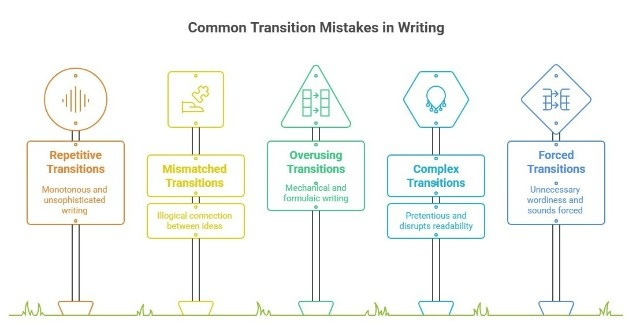
Mistake #1: Using the Same Transition Repeatedly
Bad example:
"First, climate change affects weather patterns. Also, it impacts agriculture. Also, it threatens coastal cities. Also, it disrupts ecosystems."
Why it's bad: Repetitive and monotonous. Shows limited vocabulary and sounds unsophisticated.
Fixed with variety:
"First, climate change affects weather patterns. Additionally, it impacts agriculture and food security. Furthermore, rising sea levels threaten coastal cities. Finally, it disrupts ecosystems worldwide."
Pro tip: Vary your transitions even within the same category. Don't use "furthermore" three times in one essay. Your essay writing improves dramatically with varied transitions.
Mistake #2: Transition Doesn't Match the Logical Relationship
Bad example:
"Renewable energy costs have decreased dramatically. Therefore, fossil fuel companies continue dominating the market."
Why it's bad: "Therefore" signals cause-effect, but decreasing renewable costs don't cause fossil fuel dominance. These are contradictory trends, not causal ones.
Fixed with proper transition:
"Renewable energy costs have decreased dramatically. Despite this, fossil fuel companies continue dominating the market due to existing infrastructure and political influence."
Pro tip: Always check that your transition accurately describes the relationship between ideas. If you're showing contrast, use contrast transitions. If showing cause-effect, use cause-effect transitions.
Mistake #3: Starting Every Sentence With a Transition
Bad example:
"First, social media affects teenagers. Second, it can cause anxiety. However, it also helps them connect. Therefore, parents should monitor usage. In conclusion, balance is important."
Why it's bad: Overuse makes transitions lose impact. Sounds mechanical and formulaic, like you're following a template rather than thinking.
Fixed with strategic placement:
"Social media significantly affects teenagers' mental health. Studies show excessive use can cause anxiety and depression. It also, however, helps adolescents maintain friendships and find communities. Given these competing effects, parents should monitor usage while respecting teens' need for social connection."
Pro tip: Use transitions at major shifts in logic, not every sentence. Aim for 2-3 transitions per paragraph for optimal readability. Also, see our guide on topic sentences for paragraph-level organization.
Mistake #4: Using Overly Complex Transitions in Simple Writing
Bad example (for high school essay):
"Notwithstanding the aforementioned considerations, the committee reached a consensus. Subsequently, implementation commenced forthwith."
Why it's bad: Unnecessarily complex for the context. Sounds pretentious and disrupts readability. Your audience matters.
Fixed with appropriate complexity:
"Despite these concerns, the committee agreed on a solution. Then, they began implementing the changes immediately."
Pro tip: Match transition complexity to your audience and essay type. College essays (i.e. research essays) can use sophisticated transitions; argumentative essays should use clear, direct ones.
Mistake #5: Forcing Transitions Where Natural Flow Exists
Bad example:
"Shakespeare wrote 37 plays. Furthermore, he also wrote 154 sonnets. Moreover, these works influenced literature for centuries."
Why it's bad: The ideas connect naturally without transitions. Adding them creates unnecessary wordiness and sounds forced.
Fixed by removing forced transitions:
"Shakespeare wrote 37 plays and 154 sonnets—works that influenced literature for centuries."
Pro tip: Not every connection needs a transition. Use them when the relationship between ideas isn't immediately obvious to readers.
Your Time Is Worth More Than This
Get Hours Back. Get a Better Essay
Zero AI. Zero plagiarism. Just expert-level writing.
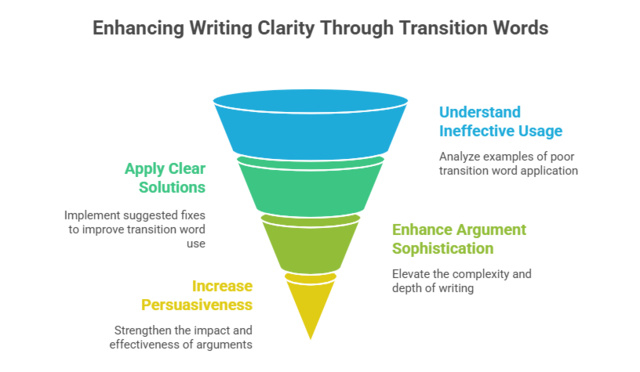
Transition Words for Different Essay Types
While the six main categories work universally, certain essay types benefit from specific transition strategies.
Argumentative Essays: Building Persuasive Logic
Argumentative essays require transitions that show logical progression and address counterarguments.
Essential transitions for argumentation:
Introducing evidence: "According to research," "Studies demonstrate," "Data reveals," "Research shows"
Acknowledging opposition: "Admittedly," "Critics argue," "Some contend," "Opponents claim," "It is true that"
Refuting counterarguments: "However, this view overlooks," "This argument fails to consider," "In reality," "On closer examination"
Strengthening claims: "More importantly," "Most significantly," "Above all," "Particularly," "Especially"
Example paragraph structure:
"Proponents claim that standardized testing measures academic ability fairly. However, this view overlooks the strong correlation between test scores and family income. In fact, research demonstrates that SAT scores predict parental wealth more accurately than student potential. Moreover, test prep services cost thousands of dollars, creating advantages only wealthy families can afford. Therefore, colleges should eliminate standardized testing requirements to improve equity."
Narrative Essays: Controlling Pace and Time
Narrative essays use sequential transitions to control pacing and guide readers through events.
Essential transitions for narrative:
Time progression: "Initially," "Soon after," "Later that evening," "By morning," "Eventually," "After some time"
Flashbacks: "Earlier that day," "Looking back," "Previously," "Before this," "Years earlier"
Pivotal moments: "Suddenly," "At that moment," "Without warning," "In an instant," "Just then"
Reflection: "Looking back," "In retrospect," "Now I understand," "This taught me," "I learned that"
Example narrative flow:
"Initially, I thought the job would be easy. However, within hours, I realized my mistake. By the end of my first shift, my hands were blistered and my back ached. Looking back now, I understand that this physical hardship taught me more about perseverance than any classroom lesson. That summer ultimately shaped my work ethic for years to come."
Compare and Contrast Essays: Balancing Similarities and Differences
Compare and contrast essays alternate between showing similarities and differences clearly.
Essential transitions for comparison:
Similarities: "Similarly," "Likewise," "In the same way," "Equally," "Just as," "Both," "Also," "Correspondingly"
Differences: "In contrast," "Conversely," "On the other hand," "Unlike," "Whereas," "While," "However"
Degree: "More than," "Less than," "To a greater extent," "To a lesser degree," "Significantly more/less"
Example comparison structure:
"Both online and traditional education provide structured learning environments with clear expectations. Similarly, each requires substantial student engagement and self-discipline to succeed. However, online education offers scheduling flexibility that traditional classrooms cannot match. Conversely, in-person instruction provides immediate feedback and spontaneous discussion that remote learning struggles to replicate. Whereas online courses suit working adults, traditional formats better serve students who need structured accountability."
Strategic Placement: Where Transitions Work Best
Starting Paragraphs: Linking to Previous Ideas
Topic sentences should connect to the previous paragraph, showing how your argument progresses logically.
Effective paragraph starters:
- "Building on this evidence, we must consider the broader implications..."
- "In contrast to this view, recent research suggests a different interpretation..."
- "These benefits notwithstanding, several significant challenges remain..."
- "While the previous example demonstrates, further analysis reveals..."
Within Paragraphs: Connecting Supporting Points
Internal transitions link your evidence and analysis smoothly without feeling mechanical.
Mid-paragraph transitions:
- After presenting evidence: "This data demonstrates the clear correlation between..."
- Before analysis: "This pattern suggests that underlying factors include..."
- Between examples: "Another instance of this trend appears in..."
- Introducing quotes: "As Smith argues, the policy fails because..."
Ending Sections: Preparing for What's Next
Strong sections end by hinting at the next topic, creating smooth flow between major ideas.
Section-ending transitions:
"While these advantages are significant, the disadvantages deserve equal consideration."
"Having established the problem's severity, we now examine potential solutions."
"These statistics reveal the impact, but deeper causes require investigation." - "With this context established, we can now evaluate specific policies."
Learn more about structuring complete essay in our guide on writing conventions for college students.
Transitions as Strategic Tools
Think of transition words as signposts guiding readers through your argument. Each transition reveals your thinking process: how ideas connect, contrast, or build upon each other logically. Weak writers use transitions randomly or not at all, leaving readers confused. Strong writers use them strategically to make complex arguments easy to follow.
The 75 essential transitions in this guide, organized by function, give you everything you need to write coherent, professional essays. You don't need to memorize hundreds of transitions—you need to understand the six core functions (addition, contrast, cause-effect, sequence, emphasis, conclusion) and choose transitions that accurately reflect your logical relationships.
Remember: Transitions improve flow, but they can't fix unclear thinking. If you struggle placing transitions, the problem might be organization, not vocabulary. Step back, ensure your ideas follow logically. Do this by following a complete essay writing guide and then add transitions that make those connections explicit to readers.
Why Struggle When Experts Can Do It Better? Thousands of students trust us to deliver essays that get the grades they deserve. 100% human-written. Satisfaction guaranteed.
Next Steps: Mastering Essay Structure Beyond Transitions
Transition words improve flow, but they work best within well-structured essays. Now that you understand transitions, focus on these related skills:
Essential essay writing resources:
Essay Writing Guide - Master the complete essay writing process from brainstorming to final revision, including how transitions fit into overall structure and organization.
How to Write a Thesis Statement - Craft compelling thesis statements that set up your essay's logical flow and prepare readers for your transitions between supporting points.
Topic Sentence vs Thesis Statement - Write strong topic sentences that naturally incorporate transitions linking back to your thesis and previous paragraphs for seamless flow.
Essay Outline Guide - Create detailed outlines that plan logical progression, making it easy to identify where transitions belong before you write your first draft.
Start with structure through careful outlining, then write clear topic sentences with strong main ideas, and finally add strategic transitions that highlight your logical connections. This sequence is more effective than adding transitions to poorly organized writing. Strong transitions enhance good structure; they can't fix fundamental organizational problems or unclear thinking.
Downloadable Resource
Download and use the following Quick Reference Guide and use its essential transition words to make your essays flow clearly and logically.






